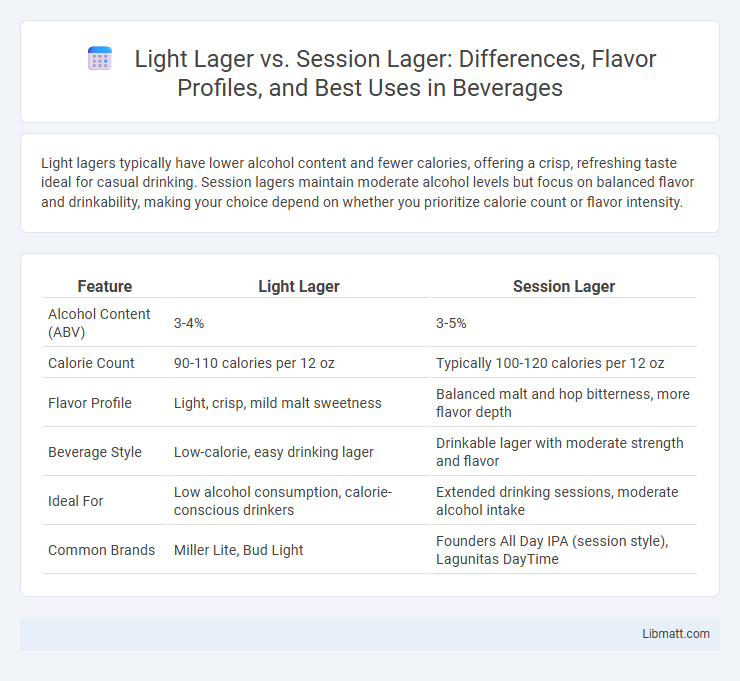Light lagers typically have lower alcohol content and fewer calories, offering a crisp, refreshing taste ideal for casual drinking. Session lagers maintain moderate alcohol levels but focus on balanced flavor and drinkability, making your choice depend on whether you prioritize calorie count or flavor intensity.
Table of Comparison
| Feature | Light Lager | Session Lager |
|---|---|---|
| Alcohol Content (ABV) | 3-4% | 3-5% |
| Calorie Count | 90-110 calories per 12 oz | Typically 100-120 calories per 12 oz |
| Flavor Profile | Light, crisp, mild malt sweetness | Balanced malt and hop bitterness, more flavor depth |
| Beverage Style | Low-calorie, easy drinking lager | Drinkable lager with moderate strength and flavor |
| Ideal For | Low alcohol consumption, calorie-conscious drinkers | Extended drinking sessions, moderate alcohol intake |
| Common Brands | Miller Lite, Bud Light | Founders All Day IPA (session style), Lagunitas DayTime |
Understanding Light Lager: Key Characteristics
Light lagers have a lower alcohol content, typically around 3-4% ABV, and a lighter body compared to regular lagers, making them more refreshing and less filling. They feature a pale golden color, mild hop bitterness, and a clean, crisp finish, which appeals to drinkers seeking a subtle flavor profile. Common ingredients include highly fermented malt and adjuncts like rice or corn, reducing residual sugars and calories while maintaining drinkability.
Defining Session Lager: An Overview
Session lager is a type of beer characterized by its lower alcohol content, typically ranging between 3% to 5% ABV, designed for prolonged drinking sessions without overwhelming intoxication. Unlike traditional light lagers, session lagers maintain fuller malt flavors and balanced bitterness, offering a more satisfying taste while remaining easy to drink. Your choice of session lager provides a refreshing option that combines drinkability with consistent flavor, ideal for social gatherings or casual enjoyment.
Origins and History of Light and Session Lagers
Light lagers originated in the United States during the 1960s as a response to consumer demand for lower-calorie and lower-alcohol beers, with brands like Miller Lite pioneering the category. Session lagers trace their roots to traditional European brewing, particularly British and German styles, characterized by moderate alcohol content typically below 4.5% ABV, designed for extended social drinking without intense intoxication. Both styles evolved to meet changing market preferences, with light lagers focusing on calorie-conscious drinkers and session lagers on maintaining beer flavor while facilitating prolonged consumption.
Brewing Process Differences
Light lagers undergo a brewing process with extended filtration and dilution steps to reduce alcohol content and calories while maintaining a crisp taste. Session lagers are brewed with a balanced malt profile and shorter fermentation times, emphasizing drinkability and moderate alcohol levels. Your choice depends on whether you prefer a lighter, easy-drinking beer or a more flavorful, lower-alcohol option.
ABV Comparison: Light vs Session Lager
Light lagers typically have an alcohol by volume (ABV) ranging from 3.2% to 4.0%, emphasizing lower calorie content and a lighter taste profile. Session lagers generally feature a slightly higher ABV, around 4.0% to 5.0%, balancing moderate alcohol strength with drinkability for extended consumption. The key distinction lies in session lagers providing more flavor complexity and alcohol presence while maintaining a smooth, easy-drinking experience compared to the often milder light lagers.
Flavor Profiles: What to Expect
Light lagers exhibit a crisp, clean flavor with subtle malt sweetness and minimal hop bitterness, making them highly refreshing and approachable. Session lagers offer a more balanced profile with moderate malt character and gentle hop aroma, designed to maintain flavor complexity despite lower alcohol content. Your choice depends on whether you prefer a straightforward, easy-drinking beer or a flavorful yet sessionable brew.
Calorie and Carb Content Analysis
Light lagers typically contain fewer calories and carbs, averaging around 90-110 calories and 3-6 grams of carbohydrates per 12-ounce serving, making them ideal for those watching their intake. Session lagers often have slightly higher calories and carbs, generally ranging from 110-130 calories and 7-10 grams of carbohydrates, due to a slightly higher alcohol content. Understanding these differences helps you choose a beer that fits your dietary goals without compromising on flavor or drinking experience.
Popular Brands and Market Trends
Light lagers, exemplified by popular brands such as Bud Light, Coors Light, and Miller Lite, dominate the market with their low-calorie appeal and widespread availability. Session lagers, including offerings from brands like All Day IPA by Founders and Dale's Pale Ale by Oskar Blues, are gaining traction among craft beer enthusiasts seeking lower alcohol content with full flavor. Market trends indicate rising consumer interest in session lagers as drinkers prioritize moderate alcohol consumption and craft-quality taste, fueling growth in this niche segment.
Food Pairing Recommendations
Light lagers pair exceptionally well with mild, fresh foods such as grilled chicken, seafood, and salads, enhancing subtle flavors without overpowering the palate. Session lagers complement spicy dishes, including Mexican cuisine and light curries, balancing heat with their moderate hop bitterness and refreshing carbonation. Both beer styles work perfectly with appetizers like pretzels and light cheeses, making them versatile choices for casual dining.
Choosing the Right Lager for You
Light lagers offer a crisp, low-calorie option ideal for those seeking a refreshing beer with mild flavor and lower alcohol content, typically around 3-4% ABV. Session lagers provide a balanced taste with moderate hop bitterness and an alcohol range of 3-5% ABV, making them suitable for prolonged drinking sessions without overwhelming the palate. Selecting between light and session lagers depends on your preference for calorie intake, flavor intensity, and occasion.
Light lager vs session lager Infographic

 libmatt.com
libmatt.com